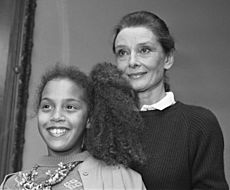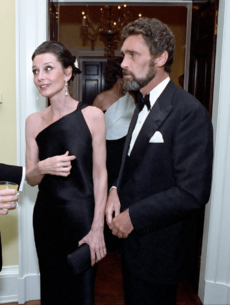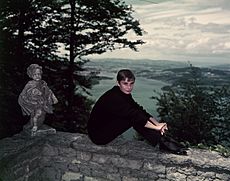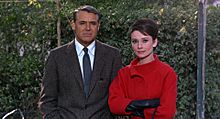Audrey Hepburn facts for kids
Quick facts for kids
Audrey Hepburn
|
|
|---|---|
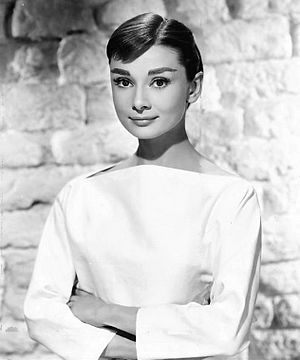
Hepburn in 1956
|
|
| Born |
Audrey Kathleen Ruston
4 May 1929 Ixelles, Brussels, Belgium
|
| Died | 20 January 1993 (aged 63) Tolochenaz, Vaud, Switzerland
|
| Resting place | Tolochenaz Cemetery, Tolochenaz |
| Nationality | British |
| Occupation |
|
| Years active |
|
|
Notable work
|
Full list |
| Spouse(s) | |
| Partner(s) | Robert Wolders (1980–1993; her death) |
| Children | 2, including Sean |
| Parent(s) |
|
| Relatives |
|
| Awards | Full list |
| Goodwill Ambassador for UNICEF | |
| In office 1989–1993 |
|
| Signature | |
Audrey Hepburn (born Audrey Kathleen Ruston; 4 May 1929 – 20 January 1993) was a famous British actress and humanitarian. She was known as a film and fashion icon. The American Film Institute ranked her as the third-greatest female screen legend from the Classical Hollywood cinema era.
Audrey was born in Ixelles, Brussels, Belgium, into an important family. She spent parts of her childhood in Belgium, England, and the Netherlands. She loved ballet and studied it in Amsterdam and London. She started her career as a dancer in musical theater shows.
Audrey became a huge star with the romantic comedy Roman Holiday (1953). For this movie, she was the first actress to win an Oscar, a Golden Globe Award, and a BAFTA Award for one role. In the same year, she also won a Tony Award for her performance in the play Ondine.
She starred in many other popular films. These include Sabrina (1954), Funny Face (1957), The Nun's Story (1959), Breakfast at Tiffany's (1961), Charade (1963), and My Fair Lady (1964). In 1967, she starred in the thriller Wait Until Dark, earning more award nominations. Later, she appeared in films less often, like Robin and Marian (1976). Her last performances were in a TV series called Gardens of the World with Audrey Hepburn, for which she won an Emmy Award.
Audrey won three BAFTA Awards for Best British Actress. She also received special awards for her amazing film career, including a BAFTA Lifetime Achievement Award. She is one of only eighteen people who have won an Oscar, Emmy, Grammy, and Tony Award (EGOT). Later in her life, Audrey spent a lot of time helping UNICEF, an organization that helps children. She worked in some of the poorest communities in Africa, South America, and Asia. In 1992, she received the US Presidential Medal of Freedom for her work as a UNICEF Goodwill Ambassador. She passed away a month later from cancer at her home in Tolochenaz, Switzerland, at age 63.
Contents
Audrey Hepburn's Early Life
Childhood and Family (1929–1938)
Audrey Kathleen Ruston was born on May 4, 1929, in Ixelles, Brussels, Belgium. Her family called her Adriaantje.

Audrey's mother, Baroness Ella van Heemstra, was a Dutch noblewoman. Her grandfather, Baron Aarnoud van Heemstra, was a mayor and later a governor in a Dutch colony. Audrey's father, Joseph Victor Anthony Ruston, was British. He later added "Hepburn" to his name.
Audrey's parents married in 1926 and moved to Europe. Her early childhood was comfortable and privileged. She traveled between Belgium, the Netherlands, and England because of her father's job.
In 1935, when Audrey was six, her father suddenly left the family. This was a very difficult time for her. She later said it was "the most traumatic event of my life." Her mother then moved with Audrey to her family's home in Arnhem, Netherlands. In 1937, Audrey was sent to a private school in Elham, England. Her parents officially divorced in 1938. Years later, Audrey found her father through the Red Cross and supported him financially.
Life During World War II (1939–1945)
In September 1939, Britain declared war on Germany. Audrey's mother moved her back to Arnhem, hoping the Netherlands would stay neutral. While there, Audrey attended the Arnhem Conservatory from 1939 to 1945. She continued her ballet training. After Germany invaded the Netherlands in 1940, Audrey used the name Edda van Heemstra. An "English-sounding" name was dangerous during the German occupation.
Her family suffered greatly during the war. In 1942, her uncle was executed by the Germans. Her half-brother Ian was sent to a German labor camp, and her other half-brother Alex went into hiding.
Audrey, her mother, and aunt moved to Velp. Audrey performed silent dance shows to raise money for the Dutch resistance. She also delivered an underground newspaper and took messages and food to Allied pilots hiding nearby. She volunteered at a hospital that was a center for resistance activities. Her family even hid a British paratrooper in their home during the Battle of Arnhem. Audrey saw Dutch Jews being taken to concentration camps, which deeply affected her.
Living conditions worsened after D-Day. During the 1944-45 Dutch famine, food and fuel were scarce. Audrey's family had to make flour from tulip bulbs to bake. After the war, Audrey became very ill from malnutrition. She suffered from jaundice, anaemia, and a respiratory infection. She recovered thanks to medicine sent by a family friend. However, her family lost much of their wealth and property during the occupation.
Audrey Hepburn's Acting Career
Ballet and Early Roles (1945–1952)
After the war, Audrey moved to Amsterdam with her family. She continued her ballet training. Her mother worked as a cook to support them. Audrey made her film debut in Dutch in Seven Lessons (1948).
Later that year, Audrey moved to London for a ballet scholarship. She worked part-time as a model. She was told that her height and weak health (from wartime malnutrition) meant she couldn't become a top ballerina. So, she decided to focus on acting instead.
Audrey appeared as a dancer in West End musical shows like High Button Shoes (1948) and Sauce Tartare (1949). She also took acting lessons. She got small roles in several films, including The Lavender Hill Mob (1951). Her first important supporting role was in Secret People (1952), where she played a talented ballerina.
While filming in Monte Carlo, French writer Colette saw Audrey. Colette decided to cast her in the main role of the Broadway play Gigi. Audrey had never spoken on stage before and needed special coaching. When Gigi opened, critics praised her performance. Life magazine called her a "hit." Audrey also won a Theatre World Award for the role.
Roman Holiday and Becoming a Star (1953–1960)
Audrey's first starring role was in Roman Holiday (1953). She played Princess Ann, a European princess who escapes her royal duties for a fun night with an American reporter (Gregory Peck). The director, William Wyler, was very impressed by Audrey's screen test. He chose her over other famous actresses. Gregory Peck even insisted that Audrey's name be shown as prominently as his in the movie's credits.
The film was a huge success. Audrey received great praise and won an Academy Award for Best Actress, a BAFTA Award, and a Golden Globe Award for Best Actress – Motion Picture Drama in 1953. A critic from The New York Times called her "a slender, elfin, and wistful beauty."
After Roman Holiday, Audrey signed a contract for seven films with Paramount. She also became known for her personal style. She then starred in the romantic comedy Sabrina (1954). In this film, two wealthy brothers (Humphrey Bogart and William Holden) compete for her character's love. She was nominated for another Oscar and won another BAFTA Award for this role.
In 1954, Audrey also returned to the stage in the play Ondine. She played a water nymph who falls in love with a human. Her performance won her a Tony Award for Best Performance by a Leading Actress in a Play. This made her one of only three actresses to win an Oscar and a Tony Award for Best Actress in the same year. During the play, Audrey and her co-star Mel Ferrer started dating. They married on September 25, 1954.
Audrey continued to star in successful films. She played Natasha Rostova in War and Peace (1956), a film based on the famous novel. She showed her dancing skills in her first musical film, Funny Face (1957), with Fred Astaire. She also starred in the romantic comedy Love in the Afternoon (1957) with Gary Cooper.
Audrey played Sister Luke in The Nun's Story (1959). This role, about a nun's struggles, earned her a third Oscar nomination and a second BAFTA Award. Critics praised her performance, calling it her "finest." Audrey spent a year preparing for this role.
Her next films, Green Mansions (1959) and The Unforgiven (1960), received mixed reviews. The Unforgiven was her only western film.
Continued Success (1961–1967)
Audrey's next iconic role was Holly Golightly in Breakfast at Tiffany's (1961). This film was based on a book by Truman Capote. The character of Holly is one of the most famous in American cinema. The black dress she wears in the opening scene is considered a fashion icon. Audrey said playing Holly was "the jazziest of my career" but also "the hardest thing I ever did" because she was naturally shy. She was nominated for another Oscar for this role.
In the same year, Audrey also starred in the drama The Children's Hour (1961) with Shirley MacLaine. They played teachers accused of being lesbians. Critics praised Audrey's sensitive performance.
Audrey then appeared with Cary Grant in the thriller Charade (1963). She played a young widow chased by men who want her murdered husband's stolen money. Cary Grant enjoyed working with her, saying, "All I want for Christmas is another picture with Audrey Hepburn." This role earned Audrey her third BAFTA Award and another Golden Globe nomination.
Audrey reunited with her Sabrina co-star William Holden in Paris When It Sizzles (1964). This comedy was not well-received by critics, but they still liked Audrey's performance.
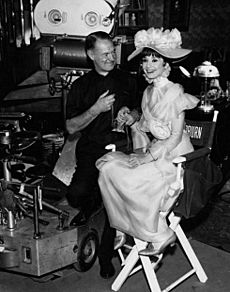
Audrey's second film in 1964 was My Fair Lady, a film version of the popular musical. Her casting as Eliza Doolittle, a Cockney flower girl, was debated because Julie Andrews had played the role on stage. Although Audrey sang in Funny Face, her singing in My Fair Lady was mostly dubbed by another singer.
Despite the controversy, critics loved Audrey's performance. One critic wrote, "Audrey Hepburn is magnificent. She is Eliza for the ages." Another said her performance was "the best of her career."
As the 1960s continued, Audrey appeared in different types of films. She starred in the heist comedy How to Steal a Million (1966). She played the daughter of an art collector whose fake art collection is about to be discovered. She tries to help her father with the help of a man played by Peter O'Toole.
In 1967, she made two more films. The first was Two for the Road, a unique comedy-drama about a couple's troubled marriage. The second was Wait Until Dark, a suspense thriller. Audrey showed her acting range by playing a terrorized blind woman. This role earned her her fifth and final Oscar nomination for Best Actress.
Later Career and Final Projects (1968–1993)
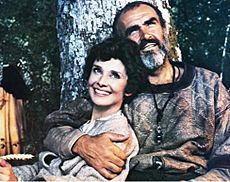
After 1967, Audrey chose to spend more time with her family. She acted only sometimes. She returned to film as Maid Marian in Robin and Marian (1976) with Sean Connery as Robin Hood. The film was somewhat successful. Critic Roger Ebert praised Audrey's chemistry with Connery.
Audrey then appeared in Bloodline (1979), an international thriller, which was not successful. Her last starring role in a film was in the comedy They All Laughed (1981). Six years later, she co-starred in a TV movie called Love Among Thieves (1987).
After a small role as an angel in Steven Spielberg's Always (1989), Audrey completed two more projects. Gardens of the World with Audrey Hepburn was a PBS documentary series filmed in seven countries. For an episode of this series, Audrey won a Primetime Emmy Award after her death. Her other project was a spoken word album, Audrey Hepburn's Enchanted Tales, recorded in 1992. It featured her reading classic children's stories and earned her a Grammy Award for Best Spoken Word Album for Children after she passed away.
Audrey Hepburn's Humanitarian Work
In the 1950s, Audrey narrated two radio shows for UNICEF, telling children's war stories. In 1989, she was named a Goodwill Ambassador of UNICEF. She said she was thankful for the international aid she received as a child during the war and wanted to show her gratitude.
UNICEF Missions (1988–1992)
Audrey's first mission for UNICEF was to Ethiopia in 1988. She visited an orphanage with 500 starving children and arranged for UNICEF to send food.
In August 1988, Audrey went to Turkey for an immunization campaign. She called Turkey a great example of what UNICEF could do. She said the army and even fishmongers helped deliver vaccines. In October, she visited South America. She told the United States Congress that she saw small communities get water systems for the first time, calling it a "miracle" from UNICEF.
Audrey toured Central America in February 1989. She met with leaders in Honduras, El Salvador, and Guatemala. In April, she went to Sudan for "Operation Lifeline" to deliver food during a civil war. She said, "These are not natural disasters but man-made tragedies for which there is only one man-made solution – peace." In October 1989, Audrey visited Bangladesh. A UN photographer noted how easily she connected with children, hugging them even when they were sick.
In October 1990, Audrey went to Vietnam to help with UNICEF's immunization and clean water programs. In September 1992, just four months before she died, Audrey went to Somalia. She called it "apocalyptic" and said she had never seen anything so bad.
Awards for Humanitarian Work
United States President George H. W. Bush gave Audrey the Presidential Medal of Freedom for her work with UNICEF. The Academy of Motion Picture Arts and Sciences also gave her the Jean Hersholt Humanitarian Award after her death for her contributions to humanity. In 2002, UNICEF honored Audrey's humanitarian work by unveiling a statue called "The Spirit of Audrey" at their New York headquarters. The United States Fund for UNICEF also has an Audrey Hepburn Society to recognize her service to children.
Audrey Hepburn's Personal Life
Marriages and Family
In 1952, Audrey was engaged to businessman James Hanson. She called it "love at first sight." However, she decided not to marry him because their busy careers would keep them apart too much. She wanted to be "really married."
Audrey met American actor Mel Ferrer at a party. They worked together in the play Ondine and started a relationship. They married on September 25, 1954, in Switzerland. They had a son named Sean Hepburn Ferrer. Despite rumors, Audrey said she and Mel were happy together, though she admitted he had a bad temper. They divorced in 1968 after 14 years of marriage.
Audrey met her second husband, Italian psychiatrist Andrea Dotti, in 1968. She hoped to have more children and possibly stop working. They married on January 18, 1969, and their son Luca Andrea Dotti was born in 1970. Their marriage lasted over twelve years, ending in divorce in 1982.
From 1980 until her death, Audrey was in a relationship with Dutch actor Robert Wolders. She had met him through a friend. In 1989, she said the nine years with him were the happiest of her life. She considered them married, even if not officially.
Illness and Passing
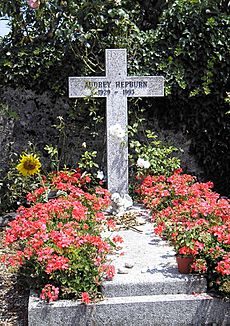
After returning from Somalia in late 1992, Audrey developed abdominal pain. Doctors found a rare form of abdominal cancer.
Audrey and her family returned to Switzerland to celebrate her last Christmas. Because she was recovering from surgery, she could not fly on a regular plane. Her friend, fashion designer Hubert de Givenchy, arranged for a private jet to take her home. She spent her last days receiving care at her home in Tolochenaz, Switzerland.
Audrey passed away peacefully in her sleep on January 20, 1993, at home. Her funeral was held at the village church in Tolochenaz on January 24, 1993. Many family members and friends attended, including her sons, partner Robert Wolders, and ex-husbands. Later that day, Audrey was buried at the Tolochenaz Cemetery.
Audrey Hepburn's Legacy
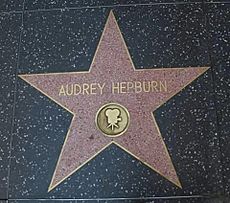
Audrey Hepburn's influence continues long after her death. The American Film Institute named her the third-greatest female star of all time. She is one of the few entertainers to win an Oscar, Emmy, Grammy, and Tony Award. She won a record three BAFTA Awards for Best British Actress.
In her later years, she remained active in the film world. She received a Lifetime Achievement Award from BAFTA in 1992. She also received many awards after her death, including the 1993 Jean Hersholt Humanitarian Award and competitive Grammy and Emmy Awards. In 2009, The Times newspaper listed her among the top 10 British actresses ever.
Audrey's image is still used in advertising campaigns worldwide. For example, a 2006 Gap commercial used clips of her dancing from Funny Face. In 2013, a computer-generated image of Audrey was used in a TV ad for a chocolate bar. On May 4, 2014, Google honored her with a special doodle on her 85th birthday.
Her son, Sean Ferrer, founded the Audrey Hepburn Children's Fund to continue her humanitarian work. This charity raises money through exhibitions of Audrey Hepburn's belongings. Her son Luca Dotti also supports a charity for a rare cancer, the same type that Audrey had. Audrey's son Sean said that his mother was raised as a normal child, not in Hollywood. He said she didn't take herself too seriously, but she took her work very seriously.
Public Image and Style Icon
Audrey Hepburn was famous for her fashion choices and unique look. In 1954, a fashion photographer called her "the public embodiment of our new feminine ideal."
Audrey was known for a simple, minimalistic style. She often wore clothes with clean lines, single colors, and special accessories. She was especially linked to French fashion designer Hubert de Givenchy. He designed her costumes for many films, starting with Sabrina (1954). Givenchy and Audrey became lifelong friends.
Givenchy designed her costumes for films like Breakfast at Tiffany's (1961) and Charade (1963). He also dressed her off-screen. Fashion was very important in many of Audrey's films. She also became the face of Givenchy's first perfume, L'Interdit, in 1957. Audrey also helped boost sales of Burberry trench coats after wearing one in Breakfast at Tiffany's.
In her private life, Audrey preferred comfortable, casual clothes. Even though many admired her beauty, she never thought of herself as attractive.
Audrey's influence as a style icon continues decades after her acting career. Magazines often show how to get her look, and designers use her as inspiration. Her film costumes sell for large amounts of money at auctions. For example, one of the little black dresses from Breakfast at Tiffany's sold for over £467,000 in 2006.
Filmography and Stage Roles
Audrey Hepburn is remembered as one of the most beautiful women of all time. The American Film Institute ranked her as the third greatest screen legend in American cinema. She is also known as both a film and style icon. Her first film role was a flight attendant in the 1948 Dutch film Dutch in Seven Lessons. She then performed on the British stage as a dancer in musicals like High Button Shoes (1948) and Sauce Tartare (1949). Two years later, she made her Broadway debut in the main role of the play Gigi.
Audrey's Hollywood debut was as a runaway princess in William Wyler's Roman Holiday (1953) with Gregory Peck. This role made her a star. For her performance, she won the Academy Award for Best Actress, the BAFTA Award for Best British Actress, and the Golden Globe Award for Best Actress in a Motion Picture – Drama. In 1954, she played a chauffeur's daughter in a love triangle in Billy Wilder's romantic comedy Sabrina with Humphrey Bogart and William Holden. In the same year, Audrey won the Tony Award for Best Actress in a Play for playing the water nymph in the play Ondine.
Awards and Honours
Audrey Hepburn received many awards and honors during her career. She won or was nominated for awards for her work in movies, television, spoken-word recordings, on stage, and for her humanitarian efforts. She was nominated five times for an Academy Award. She won the 1953 Academy Award for Best Actress for her role in Roman Holiday. She also received the Jean Hersholt Humanitarian Award in 1993, after her death, for her humanitarian work. From 5 nominations, she won a record three BAFTA Awards for Best British Actress in a Leading Role. She also received a special BAFTA Award in 1992.
See Also
 In Spanish: Audrey Hepburn para niños
In Spanish: Audrey Hepburn para niños
- L'Interdit
- List of EGOT winners
- Sophia (robot) – A humanoid robot modelled after Audrey Hepburn
- White floral Givenchy dress of Audrey Hepburn (Academy Awards, 1954)
Images for kids




